Pálffy Szölöbirtok és Pince
by
Kathy Sullivan
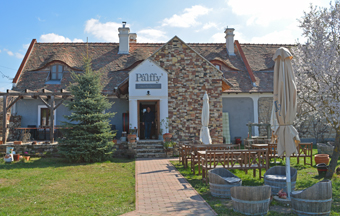 Summary: Pálffy Szölöbirtok és Pince (Vineyard and Cellar) in Köveskál village is located in the Balaton-Felvidék wine region. At Pálffy the emphasis is on producing quality wines and on the terroir of the vineyards.
Summary: Pálffy Szölöbirtok és Pince (Vineyard and Cellar) in Köveskál village is located in the Balaton-Felvidék wine region. At Pálffy the emphasis is on producing quality wines and on the terroir of the vineyards.
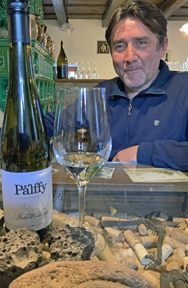 Upon our arrival at Pálffy located in the small village of Köveskál, we were warmly greeted by Gyula Pálffy, the owner and winemaker at the winery. Gyula’s two sons work with him. One of Gyula’s first statements was, “You just don’t sit down and drink wine, you have to work.” He took us to a grassy knoll above the winery building where we viewed the landscape stretching towards the mountains in the distance. Gyula began describing the geography of the land before us. This area is the middle of the Kali Basin, a subregion of the upper Balaton region. The land, at one time, had been under the sea. We had a 360º view of the Kali Basin. The soil is a mix of limestone, sand and clay. The Kali Basin has a limestone base. Volcanic hills are around the basin.
Upon our arrival at Pálffy located in the small village of Köveskál, we were warmly greeted by Gyula Pálffy, the owner and winemaker at the winery. Gyula’s two sons work with him. One of Gyula’s first statements was, “You just don’t sit down and drink wine, you have to work.” He took us to a grassy knoll above the winery building where we viewed the landscape stretching towards the mountains in the distance. Gyula began describing the geography of the land before us. This area is the middle of the Kali Basin, a subregion of the upper Balaton region. The land, at one time, had been under the sea. We had a 360º view of the Kali Basin. The soil is a mix of limestone, sand and clay. The Kali Basin has a limestone base. Volcanic hills are around the basin.
The vintage winery building appears to be protected from harsh winds by the knoll. The vineyards with 18 hectares (44 acres) in total are 2 kilometers (1.2 miles) away. The vineyards are 300 meters (984 feet) above the sea level. In addition to the vineyards with volcanic soil, Pálffy has one vineyard with limestone soil where volcanic ash was mixed with the limestone.
History
Gyula noted that people have been growing grapes here for 2000 years. Gyula’s family has been making wine for 800 years. The family has lived here since 1754. Gyula commented that during the Ottoman reign of 150 years, wine was not allowed to be drunk. However when the Ottomans were not present the people would tend the vineyards and make wine. During the 13th century, the family was considered a noble family and were supplying wines for the Hungarian King. Many years later, after phylloxera destroyed grapevines, Gyula’s father replanted the vineyards.
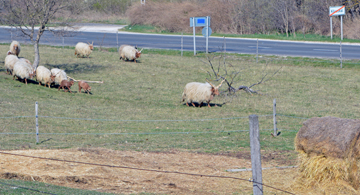 Currently Gyula is working with biodynamic techniques in the vineyard. Eventually the winery will obtain Biodynamic certification.
Currently Gyula is working with biodynamic techniques in the vineyard. Eventually the winery will obtain Biodynamic certification.
While viewing the landscape of the region, we saw an unusual flock of sheep returning from a pasture. These Hungarian sheep have long spiral horns. The Hungarian name is Racka (Hortobágy Racka Sheep). The flock of Racka also belong to Gyula Pálffy.
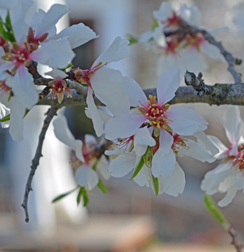 We returned to the winery tasting room where we noticed flowering almond trees in bloom. Outside of the winery/tasting room, there was outdoor seating area with umbrellas; a great place to enjoy a glass of Pálffy wine.
We returned to the winery tasting room where we noticed flowering almond trees in bloom. Outside of the winery/tasting room, there was outdoor seating area with umbrellas; a great place to enjoy a glass of Pálffy wine.
Soon it was time to step inside the winery tasting room, which we discovered offered a delightful atmosphere. The ceiling is wood with large beams. The table for our wine tasting had a glass insert covering a display of wine corks and other old winemaking instruments.
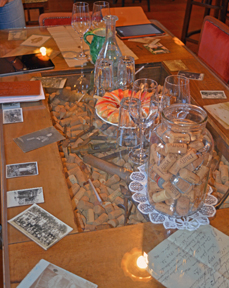 Outside of the display but under glass, numerous vintage photos were easily visible. While sitting at the table, we learned more about Gyula and his family since the decor of the room has numerous historical photos of long ago times. One photo was of Gyula’s grandfather with other soldiers when they were part of the Hungarian army during WWII. A framed family tree that dates back to 1754 is on one wall. The room also has a decorative green ceramic stove, a thick sheepskin from a Racka sheep is draped over a chair.
Outside of the display but under glass, numerous vintage photos were easily visible. While sitting at the table, we learned more about Gyula and his family since the decor of the room has numerous historical photos of long ago times. One photo was of Gyula’s grandfather with other soldiers when they were part of the Hungarian army during WWII. A framed family tree that dates back to 1754 is on one wall. The room also has a decorative green ceramic stove, a thick sheepskin from a Racka sheep is draped over a chair.
The Pálffy Wines
Our wine tasting included a round serving plate of sliced apples alternated with bread slices in the shape of a wreath. In the center were small bites of cheese.
During our wine tasting Gyula showed us several fossils that have been found in the Pálffy vineyards. These fossils indicate that the area was once under the sea.
Pálffy began the sparkling program in 2013. The Furmint grape variety is used for the sparkling wines which are produced using the traditional method. Pálffy bought land and planted more Furmint grapes. Back in 2013 the winery had to source Furmint grapes but now they are growing enough of their own Furmint and no longer need to source grapes. Furmint sparkling wines are now exported to New York City. Recently the winery sent 1,000 bottles of sparkling to New York.
The Furmint Brut 2016 had 12% alcohol. There were multiple columns of tiny bubbles forming a central mousse on the surface. The aroma was of apple and citrus. The wine had a lively mouthfeel with notes of apple and citrus. The finish was refreshing.
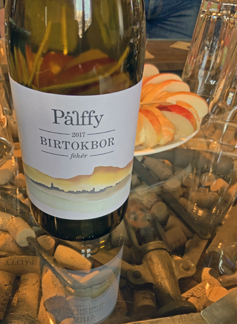 The Birtokbor 2017 fehér (white), an estate wine, was a blend of Olaszrizling, Traminer and Pinot Gris. The light yellow colored wine had some perfume and citrus aromas. The taste was of lemon and roses. The mouthfeel was smooth. The finish was crisp with layers of flavors. The aftertaste had a hint of chalk. The aftertaste was extremely long.
The Birtokbor 2017 fehér (white), an estate wine, was a blend of Olaszrizling, Traminer and Pinot Gris. The light yellow colored wine had some perfume and citrus aromas. The taste was of lemon and roses. The mouthfeel was smooth. The finish was crisp with layers of flavors. The aftertaste had a hint of chalk. The aftertaste was extremely long.
The 2017 Mál was named for the vineyard which has limestone soil. This wine with 13.5% alcohol was produced with the Olaszrizling grape variety. The wine had 4.5 g/L of residual sugar. The light yellow colored wine offered an aroma of yellow stone fruit and citrus. The mouthfeel was smooth with citrus and some nectarine. The finish began with citrusy notes, followed by apricot with a bit of mineral (chalk.)
The 2017 Fekete-hegy had 13.5% alcohol. The wine was produced with 30 to 50 year old Olaszrizling grapevines, mostly planted by Gyula’s father. The yellow colored wine was fermented in oak and aged on lees for one year. The wine offered an aroma of yellow stone fruit. The mouthfeel was velvety with notes of yellow stone fruit. The finish was fruit forward. The aftertaste was earthy.
The 2017 Juhfark wine was produced with the Juhfark grape variety. The name refers to the shape of a lamb’s tail which resembles the shape of the grape leaf. The wine was oak fermented. The wine with 12.5% alcohol was a yellow color. The aroma was of citrus and the taste had notes of grapefruit with some yellow stone fruit. The mouthfeel was silky. The finish was fruity with some mineral notes.
The 2018 Héja (the skin) was a Juhfark wine. Production included fermenting on the skins for two weeks. The wine was a gold color with a red hue. The sweet aroma had floral notes. The taste included honeysuckle, roses and citrus. The long finish had floral and mineral notes. This is a white wine that wants to be red.
A visit to Pálffy is a delightful experience with an enjoyable wine tasting and the opportunity to learn about history of the Pálffy family and the wine region.
Pálffy Szölöbirtok és Pince
Köveskál, Fő út 40, 8274 Hungary
Article written April 2019.
Please support the following Hungarian wineries and wine tour company.
| Wine a'More Travel |



